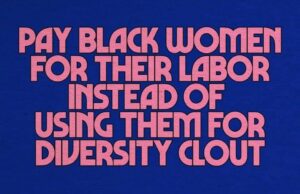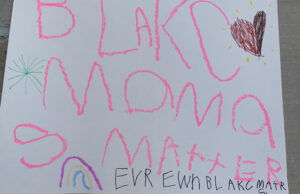THE MAKING OF A NEW ANTI-RACIST FEMINIST WORKING CLASS; #Feminism4the99
By Zillah Eisenstein

I am writing this just a few weeks after the Women’s marches of 2019. Tens of thousands of women — non-binary, trans, gender variant, queer, cis, disabled, every color, rich and poor — came out into the streets to march together to say it is time to dump the sexist/racist authoritarian; the macho fascist demagogue.
This is a chaotic time: there have been many strikes; many feminisms; many work slow-downs; many working classes in this moment. This amazing plurality of resistances is both a dilemma and an opening. I am looking at the possibility: the opportunity to see that there are new consciousnesses with many bits to them—women workers seeing themselves in their own complexity—at work, at home, as consumers, as emotional laborers; all of it. And, at the same time, the different iterations of #MeToo and its movements—in Hollywood to the prisons—allow new camaraderie.
It is a known publicized and exposed fact that women of every color, especially Black women, suffer sexual intimidation, harassment, and violence everywhere and anywhere. White supremacy has been re-exposed from the bottom up by Black Lives Matter activism and from the top by a racist president.
The present moment/s simply intensify most people’s fragility but also courage. Trumpism has created so much pain and suffering—from DACA young people (Deferred Action for Childhood Arrivals) to trans people in the military, to Black families losing their children to police violence, to a poor woman looking for the morning after pill to the almost one million workers who lost their pay checks in the government shutdown. All of us have seen the food pantries and the heartbreaking stories—how thousands of federal workers live from paycheck to paycheck and their precarity felt like ours. And, a new kind of working class that has been percolating for decades has now exploded forth.
This working class is like the old and not like the old. It is maybe more different than it is similar. And, it is more dispersed and uniquely constituted and located in different sites. I am not thinking we should rebuild the radicalism of the old working class but rather that the new radicalism must be found. This is to find our strength by coalescing together in and from our many marches, strikes, and movements to build alliances together; from the striking teachers in West Virginia, Oklahoma, Arizona, and California (and even to Greece), to the TSA workers, to the flight attendants, to the air traffic controllers, to #BlackLivesMatter.
There is a rare possibility of an expansive new working class—of all genders, races, and locations of labor. Workers of all kinds are too many to ignore: the Air Traffic Controllers who slowed down and closed Newark, Philadelphia, and LaGuardia Airports, the TSA workers who purposely did not show up for work, and Sara Nelson, president of the Flight Attendants Union, who called for a General Strike at the AFL/CIO labor movement meeting a day before the government reopened. She said: “go back with the Fierce Urgency of NOW to talk with your Locals and International unions about all workers joining together to end this Shutdown with a General Strike. We can do this. Together. Si se puede. Every gender, race, culture, and creed. We have the power.”
These workers were the reason Trump was forced to re-open the government. AND, also, don’t forget the almost one million federal workers who educated the rest of us about the hardship and heartbreak of living paycheck to paycheck. So, be my guest and cheer for Pelosi’s brinkmanship and skills. But do not forget this: workers, tons of them, women and their movements, opened the government. Individualism (and emphasis on individuals) is the language and rhetoric of neoliberalism, even if it cheers on a woman.
It is also time to stop assuming that there is one unified women’s movement, or Women’s March for that matter. Let us think, instead, as so many are, of a movement of movements—of alliances, and coalitions, where we have to relearn to negotiate our differences, such that those conversations themselves become key building blocks of insurgency.
Forget the “catfight” depiction of the organizers of the original 2017 women’s march as racist and/or anti-Semitic. There are conflicts but they reflect the wide-ranging political issues that are part of the resistance today, and not as the media likes to profess – a sign of our weakness and destruction, as Michelle Goldberg would have it. The differences of and in feminisms is a sign of political acumen and activist/honest struggle against white supremacy.
The determination and resilience of women and feminists of every kind, here and abroad, are developing at an astonishing speed not to be deterred. So, do not expect the New York Times to advertise our revolution; it rather tries to disassemble it.
History always gives us new possibilities. The #BlackLivesMatter, the #SayHerName, and the #MeToo! movements cut swaths of new loyalties across more singular sites. While sexual violence and intimidation have escalated under neoliberalism, the resistance to it has now been mobilized, nationally and internationally. Similarly, poverty and unequal wages now unites restaurant workers and teachers and most wage-earning women into a newly shared class-consciousness, often global. Our lives continue to radicalize us.
There are women now governing the CIA and military sites, and there are neo-liberal feminists who support a #Feminism4the1%. But the 2018-midterm elections were a huge gain for women of color and radical women standing for Palestine and for socialism. Alliances and movements outside the electoral arena will be crucial to any radical and revolutionary progress. And, the alliances between different/differing priorities actually help to radicalize our standpoint.
I, along with many of my anti-racist and socialist feminist sisters under the skin are not giving up—especially not now when we face a horrific and punishing politics of Trumpism that threatens the lives of too many, here and abroad.
Marches and strikes and collective actions restore us. The shared bodily presence empowers and sustains and builds trust. NPR’s Asma Khalid interviewed several women about the Women’s March (2019). One woman living in a suburb of Detroit said her local group was going to march because what they were doing was bigger than any problem with the national organizers. Whatever their inadequacies are she felt that defeating Donald Trump in 2020 was urgent and trumped everything else, so to speak.
There were hundreds, maybe thousands of marches this year. In my state of New York alone women marched in Woodstock, Syracuse, Seneca Falls, Elmira, to name a few. There has not been much coverage of this dispersed sustained resistance and rebellion or the staunch determination of it all.
Remember, or learn, that feminism saw itself in the early 70s as structureless; there would not be a hierarchy of privilege established by individuals who lead. Let us not forget this as we coalesce from our differing movements. And standing against white privilege and its supremacy must undergird the accountability of each of us.
Donald is not the biggest problem but he is the problem for now, and if we can use him to unite across our differences, well why wouldn’t we—the inclusive “we”—do that? Last year women held signs on our marches depicting every kind of wish and hope. There was a generosity in the communities brought together. Unity did not mean homogeneity, but it did mean a strategic coming together.
I am in total support with striking and marching in this moment against Trump’s brand of white supremacist capitalist misogyny. I am also ready to push for the most radical electoral campaign to defeat Trump in 2020. I am sure that we must offer an anti-racist socialist feminist radical indictment of the misery he has created to defeat his radical hatred.
So, reform is never enough but fighting for reforms can lay the basis for revolutionary consciousness and commitment—even if few of us know what revolution will look like in this very complex and messy time. Let us build movements together to build an anti-racist socialist feminist working class.
Revolutionary acts are never simply individual and yet individuals in their movements constitute revolutionary process. So, it is not enough to get angry. It is not enough to simply ask to be heard or be seen or recognized. You cannot do it yourself (DIY); you must do it with others (DIWO).
Many feminists already know that liberal or neo-liberal feminism is not enough to make democracy work. So, as “we” demand more women in Congress and in our State Houses let us remember that getting the vote did not revolutionize society. It is crucial that we have the vote—even though too many of our votes are being suppressed and not counted and smothered by an outdated slave based Electoral College.
For now—let us keep marching, and registering voters, and campaigning, and protesting against police violence, and white supremacist penal codes and prisons, and climate change, and for a living wage, and against sexual violence, and for disabled people’s rights—and for it all. This is what the new anti-racist feminist working class agenda looks like.
Let us develop a strategic feminist political action method:
Try to connect and harmonize when possible but be honest about the differences and conflicts. Unity is not needed but shared purpose is. Stop looking for sameness and celebrate similarity instead—we are simultaneously differently connected. Be suspicious of hierarchy—use structures without white and class privilege. Continually shift the structures of organization, utilizing some new organizers alongside veteran ones. Make sure Black and women of color are leading. Look for the connections between reform and revolution rather than seeing them as opposites—keep pushing to make a reform bigger in its outcome. Be on high alert against corporate interests and ownership and branding of anything. Keep nurturing an understanding of historical oppression in today’s inequalities.
Recognize that anti-racist feminist organizing must be mobile, reparative, and restorative. Give this work and political status, theorize it, strategize it, and act on it. There are new possibilities for a socialist women of colors feminisms. Stop over-personalizing our politics but politicize ourselves in personal ways.
I want to keep marching, risking, wondering, striking, and connecting towards a #Feminism4the99.
About the author…

Zillah Eisenstein is a ground breaking political thinker, writer and activist who is always looking to find new anti-racist socialist feminist pathways. She is the author of more than twelve books and hundreds of articles detailing the continual struggles for social, racial, economic, environmental, gender, sexual, and bodily justice by women of all colors across the globe. Her newest book, ABOLITONIST SOCIALIST FEMINISM; Radicalizing the Next Revolution, will be published, spring, 2019. She has lived in Ithaca New York throughout these decades of national and global activism. She is Professor Emerita of Political Theory, Ithaca College, NY. Visit her website to access her writings.




0 comments